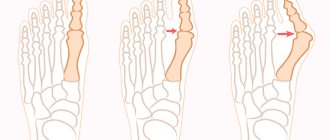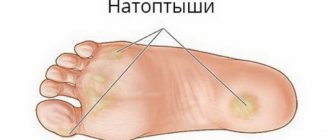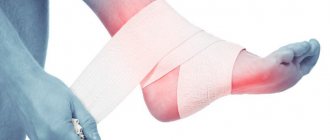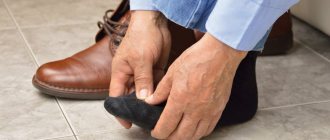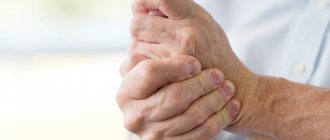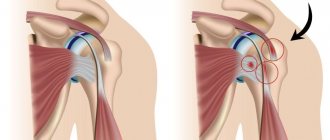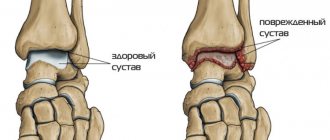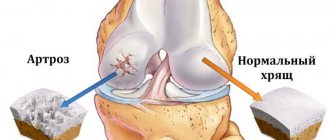Deformation of the “bones” of the big toes is one of the common problems that affects the fair sex. In men, this disease occurs only in 2% of cases. This disease not only disfigures the foot and forces women to forget about dress shoes, but also causes pain, inflammation, suppuration, and calluses.
“Bumps” on the feet appear as deformities due to deviation of the first toe. The more the first finger deviates towards the small ones, the stronger the deformity becomes, and the “bumps” become painful and the limitation of movements in the joint progresses. Hallux valgus is a term that involves the outward and inward deviation of the first toe.
Reasons for the appearance of “bumps” on the legs
- Joint diseases, all kinds of arthrosis, exostoses, bursitis, flat feet and much more can lead to an increase in the bone on the foot;
- Genetics: in many cases, this disease is inherited;
- Disruption of the endocrine system;
- Tight or incorrectly selected shoes (this risk zone includes women who, neglecting their health, prefer high heels);
- Various foot or lower leg injuries, congenital defects, as well as the results of dislocations, or improper healing of bones after fractures;
- Certain activities (such as ballet) place increased pressure on the forefoot and may increase the chances of developing a deformity.
Compresses
The effectiveness of compresses is known and recognized in both traditional and folk medicine. The main condition for their use is that the place on which the compress is applied must be wrapped in heat for 5-6 hours, and after the procedure the influence of heat must continue. Therefore, you need to stock up on wool socks, preferably made from pure sheep, dog or camel wool.
| Types of compresses | Compound | Application method | Action |
| Onion | Grated red onion, 10 percent iodine solution, gauze pad, warm water bath | The onion pulp is wrapped in a gauze napkin and applied to the bone for 6-7 hours. The compress is fixed with a plaster or bandage, a plastic bag and a woolen sock are put on top. After the procedure, the leg is rinsed with warm water, and an iodine mesh is drawn on the bone. | After applying the compress for a month, the bone decreases in size, physical discomfort and pain decrease |
| With mumiyo | Crushed Altai mummy tablet, 2 tsp. badger fat, 1 tsp. cinquefoil tincture, a piece of cotton fabric, a bath of warm water, laundry soap | The ingredients are mixed in a porcelain saucer. The resulting mixture is applied to the bone and wrapped with cotton cloth and foil. A sock is put on top. The compress lasts 3 – 5 hours. Afterwards it is washed off with a warm soapy solution (water and laundry soap). Treatment is carried out 2 – 3 times a week for 4 months | Wounds heal well, regenerate skin cells, reduce pain |
| With dimexide | Dimexide solution (dimethyl sulfoxide), 2 percent chlorophyllipt solution, cotton pad | In a shallow bowl, mix dimexide and chlorophyllipt in proportions of 1 to 3 (1 and 3 ml). Soak a cotton pad in the resulting solution and apply it to the bone overnight. The lump is wrapped in a bandage, a plastic bag and a woolen sock are put on top. The procedure is carried out for 21 days, repeated after two weeks | Pain is relieved, inflammation is prevented, and the size of the bone is reduced. |
Conservative approaches for treating “bumps”
- Laying various fabrics (for example, felt) to reduce pressure on the bunion area.
- Physiotherapy treatment: laser, ultrasound are carried out to relieve the inflammatory and degenerative manifestations of the disease.
- Any calluses or abrasions on the skin that are also a source of pain should be treated.
- In order to prevent deviation of the first toe, it is recommended to wear physiological, properly selected shoes.
- If the deformity of the toe is severe, it is necessary that the shoes stretch well, especially the toe - this will relieve pressure on the bone.
- It is recommended to wear individual orthopedic insoles, which help to correctly distribute the loads on the foot when walking and running.
- Range of motion should be improved through exercise therapy and foot massage.
What to do if a bunion grows on your foot?
The problems for owners of the unfortunate bone are not only cosmetic. Patients often complain that it is difficult for them to choose shoes and that their legs quickly get tired when walking. In addition, hallux valgus is often accompanied by such troubles as the formation of painful calluses and corns. Conclusion? Something definitely needs to be done.
Let’s say right away that the answer to a question like “Is it possible to cure a bunion with iodine?” negative. This also applies to other home remedies; they can only temporarily reduce pain.
The first step is a visit to an orthopedic doctor. He will conduct the necessary diagnostics and prescribe treatment, which can be conservative or surgical. Today, doctors have enough tools in their arsenal that allow them to do without surgery. Surgical intervention is necessary only in very advanced cases.
Treatment of a hallux valgus defect is long and difficult. It consists of selecting the right orthopedic insoles, prescribing physiotherapy, anti-inflammatory and painkillers, and massage sessions. In addition, the doctor will recommend a complex of physical therapy. In order for therapy to lead to results faster, it is advisable to go to the clinic in the early stages of the disease.
Surgical approaches to treat lumps:
, corrective osteotomies are used at SM-Clinic
. These operations allow you to get rid of deformity and preserve the joint. It is not enough to cut down the “bump”; it is necessary to eliminate the deformation of the first metatarsal bone and fix the fragments with special screw-clamps.
Patients begin to walk independently the next day after surgery wearing special postoperative shoes - Baruk shoes. After the operation, the patient spends no more than 2 days in the hospital. During this time, adequate pain relief, antibiotic therapy, dressings, physical therapy, and physiotherapy are carried out.
If you feel pain in your big toes, contact the SM-Clinic on the street. Clara Zetkin for modern surgical treatment!
Zhuravlev Kirill Andreevich traumatologist-orthopedist “SM-Clinic” on the street. Senezhskaya
You can find out more details, make an appointment with a specialist or call a doctor at home by phone
What can the patient do?
A lot also depends on the patient. Good support for treatment will be:
- wearing comfortable, non-tight shoes with low heels;
- constant use of orthopedic insoles;
- alternating activity and rest - especially important for those who work on their feet;
- weight loss if necessary.
These measures are also good for preventing hallux valgus. One last useful thing: walking barefoot on pebbles, sand, and uneven surfaces has a good effect on the condition of the feet.
You can get professional help for hallux valgus in our medical center. Come, we use modern methods with proven effectiveness in diagnosing and treating bunions!
Traditional treatment
In addition to conservative medicine, there are also methods of using folk remedies at home. For example, it is useful to make foot baths with the addition of a solution of iodine and salt: use a tablespoon of salt and ten drops of iodine per liter of warm water. You can treat with folk remedies more gently: applying propolis and grated potatoes to the sore area relieves pain and fatigue, and improves blood flow.
In addition, treatment at home is good because it allows you not to put extra strain on your legs by going to the doctor and standing in line. A compress of twisted burdock and turpentine, which also has a relaxing effect on the muscles, helps well against tissue inflammation.
To prepare baths, you can use not only water and mineral salts, but also decoctions of various natural ingredients. When a bump appears on your thumb, it is best to use chamomile, burdock and St. John's wort. In case of severe curvature syndrome, they will well complement conservative therapy prescribed by an orthopedic doctor.
Post Views: 5,671
How to get rid of a bunion on your big toe?
What to do with hallux valgus? Is surgery necessary? Is there prevention? Let's find out together with experts.
Our experts:
- Rasul Aliyev , PhD, traumatologist-orthopedist at K+31 clinic
- Musa Maysigov , PhD, orthopedist-traumatologist and surgeon at the European Medical Center
- Nikolay Kondyrev , traumatologist-orthopedist of the highest category at the Klazko clinic
I have a lump on my foot near my big toe. What is this?
Musa Maysigov: This is a hallux valgus deformity of the thumb. When it occurs, the first metatarsal bone moves outward, and the big toe moves inward. The result is an angle that looks like some kind of protrusion. It appears to be a growth, but is actually a deformity in which the edge of the head of the first metatarsal bone protrudes.
Sometimes a swelling or “bump” in this area can occur due to gout, arthrosis or other deformities. However, these are rarer cases and do not directly relate to Hallux valgus.
Why did this happen?
Hallux Valgus
Musa Maysigov: As a rule, a combination of several factors is necessary for the development of hallux valgus. Most often this is heredity, other causes are progressive flat feet, excess weight, injuries (for example, the first metatarsophalangeal joint, fracture of the base of the first metatarsal, damage to ligaments and tendons), high-heeled shoes.
Nikolay Kondyrev: This often happens in people with connective tissue dysplasia - when the joints become too mobile. Transverse flatfoot develops, and then Hallux valgus.
This is what connective tissue dysplasia looks like: the joints become too mobile or, as doctors say, hypermobile
The lump hurts, it hurts to step on it. Why?
Musa Maysigov: Most often, pain occurs not because of the bone itself, but because the soft tissues above these bones are rubbed by shoes, which causes the tissue under the skin to become inflamed (that is, bursitis begins). There is a mucous bursa (bursa) of the first metatarsophalangeal joint. It can hurt quite a lot, turn red, and sometimes even disguise itself as gout.
In addition to uncomfortable shoes, bursitis can be caused by metabolic disorders. For example, in gout, this is due to the accumulation of uric acid crystals in the mucous bursa. If an infection gets into it, bursitis can also begin. This usually happens with chronic skin injuries (chafing, minor abrasions, too deep exfoliation of the upper layers of the skin). So if your leg hurts, you need to go to the doctor.
Which doctor should I go to?
Musa Maysigov: To an orthopedic traumatologist. If upon examination it turns out that the deformity is due to gout or arthrosis, the doctor may involve additional specialists - a rheumatologist and/or an endocrinologist.
How is the diagnosis made?
Musa Maysigov: Usually hallux valgus is visible to the naked eye: the bone protrudes, this is noticeable. But in order to be sure of everything and determine the stage of the deformity, the doctor will conduct several tests in which he will evaluate the elasticity, mobility of the joint and the rigidity of the deformity.
Nikolay Kondyrev: The patient will definitely have radiographs of both feet in direct and transverse projection: it allows you to assess the degree of deviation and give a prognosis for treatment. In the most difficult cases, computed tomography is used for diagnosis.
Is hallux valgus dangerous?
Nikolay Kondyrev: In the initial stages, this is more of an aesthetic defect. Severe deformity causes bursitis, which can become infected and inflamed.
Musa Maysigov: In general, if the deformation is severe, this often indicates advanced flatfoot. Which can directly affect the correct positioning of the legs when walking, changes in the axes in the knees, hip joints, and also disrupt the function of the cross-iliac joint.
That is, to put it simply, a person begins to shuffle, clubfoot, walk on the outer edges of the feet or with their toes inward.
Is there any way to avoid deformation?
Rasul Aliyev: Walk barefoot on grass, pebbles, and earth more often: the foot is trained to be positioned correctly only when walking on uneven surfaces and different textures. If you walk only on a flat, smooth floor, the load on the foot is distributed unevenly.
Musa Maysigov: Train. Try, for example, this exercise: lift a pencil from the floor using your toes. It develops the flexibility of this zone, and the foot deforms more slowly.
Select insoles for correcting flat feet - you can buy ready-made ones at an orthopedic salon or pick them up and fit them individually. They should not interfere with you and at the same time will perform their function - to correct the foot. Try to lose weight if you have excess weight. Let me clarify, we are talking about obesity of 1-2 degrees and above - it increases the rate of development of Hallux valgus.
Nikolay Kondyrev: Avoid tight shoes, especially high-heeled ones: they contribute to external deviation of the big toe. But flat soles are also harmful. It is best to wear shoes with 3-4 cm heels.
I only wear orthopedic shoes, but the deformation still happened. Why?
Rasul Aliyev: Because orthopedic shoes are different. Sneakers with special soles are not therapeutic and prophylactic shoes, they are more of an advertising ploy.
Nikolay Kondyrev: Select corrective shoes with an orthopedic doctor. I usually recommend custom insoles with longitudinal and transverse arch formation. I make Formthotics for myself and my family.
Musa Maysigov: But, alas, insoles may not help. After all, wearing the wrong shoes is not the only cause of hallux valgus. The issue may also be due to the characteristics of the connective tissue (dysplasia), in which the ligaments are excessively elastic. They stretch easily and deformation occurs faster. Some people are more susceptible to this deformity initially, often it is hereditary.
Is it necessary to go to the doctor if nothing hurts? Maybe we can cope at home?
Musa Maysigov: In the early stages, a conservative approach is sufficient: custom-made orthopedic insoles, exercises and an abductor splint for the big toe. There is also a procedure that reduces inflammation of the mucous membrane: a salt bath.
Dissolve sea salt in hot (35-37oC) water at the rate of 25 g of salt per 1 liter of water. Soak your feet in the solution for 25 minutes.
Thumb abduction splint
Nikolay Kondyrev: Serious deformation cannot be corrected conservatively. We either restrain its progression or carry out reconstructive surgical treatment (that is, in other words, we operate).
What to do if the lump hurts, but procedures and exercise therapy do not help?
Rasul Aliyev: If the leg hurts, swells, there is discomfort even at rest - and nothing helps, surgery is usually prescribed.
Nikolai Kondyrev: It is impossible to say exactly at what stage this happens. The decision is made by the patient; the doctor can only give his recommendations.
Do I need to prepare in any way for the operation?
Rasul Aliyev: The preparation is the same as for other operations: consultation (in this case, an orthopedist, anesthesiologist, therapist), tests, studies (ECG, X-ray/CT scan of the foot).
How long is it? Difficult? Do you need anesthesia?
Nikolay Kondyrev: Usually the operation is performed under general anesthesia, but conduction anesthesia can be used (blockade of several nerves around the ankle joint, as a result of which the person loses pain sensitivity). The choice of pain relief method depends on the scope of the intervention: there are minimally invasive operations where punctures are used, and there is a large reconstruction or operations on two feet at once.
Musa Maysigov: The classic operation goes like this. Using very precise instruments, we cut the first metatarsal bone so that its part with the joint of the first toe can be moved to the desired position, after which everything is fixed with screws. Such operations are performed through a regular incision or punctures (depending on the degree of deformation). Sometimes they are supplemented with soft tissue procedures, such as tendon transfers.
I've heard about microinvasive correction. Is this a new method of operation or a special case? Who is it suitable for?
Musa Maysigov: The operation is performed using a high-speed cutter, reminiscent of a dental drill: the bone tissue is cut, the bones are placed in the desired position. Now such an operation can be performed even with fairly advanced deformities. However, this method is not suitable for people with dysplasia. Due to increased joint mobility, deformations occur much faster. By the way, it occurs more often in women than in men.
This is what joint hypermobility looks like. This picture illustrates the symptoms of connective tissue dysplasia.
Is there rehabilitation after surgery?
Rasul Aliyev: Rehabilitation after any operation to correct hallux valgus takes on average about two months. It is impossible to say how much more or less, everything is individual.
Nikolay Kondyrev: In difficult cases, patients report satisfaction from the operation only after 3-6, or even 12 months.
Rasul Aliyev: ...But a person will be able to walk the very next day after the operation. True, you will need to wear special orthopedic shoes (they come in both summer and winter), which relieve the load on the forefoot, minimizing the load on the operated leg.
Musa Maysigov: In the first days and even weeks after the operation, your leg will hurt. Crutches are not needed, and in most cases a cast is also not needed; special bandages are used for fixation. To speed up rehabilitation, procedures may be prescribed: lymphatic drainage massage and local physiotherapy. In some cases, in the early stages, you can do gymnastics to restore the elasticity of the foot joints, but it is better to clarify this issue with your doctor individually.
Is it possible to walk in heels?
Yes. But heels higher than 3-4 cm in the first year after surgery are undesirable, says Rasul Aliyev .
How often can they be worn?
Musa Maysigov: I can’t give a specific figure, everything is individual. But the less often you do this, the better. Heels and tapered toes are the main causes of recurrence of deformity.
What complications can arise after surgery?
Rasul Aliyev: The risk of complications is small, but they cannot be excluded 100%. Possible: loss of skin sensitivity in the area of surgery, aseptic necrosis of the head of the metatarsal bone, contracture of the first metatarsophalangeal joint, secondary infection, improper fusion of bone tissue.
After surgery, can the deformity occur again?
Musa Maysigov: Maybe this happens in about 5% of cases. The main reason is increased tissue elasticity. Another reason is progressive flat feet, so after surgery it is advisable to constantly wear insoles. The third reason is sudden weight gain.
Rasul Aliyev: Be careful when choosing a doctor and following postoperative recommendations. In my experience, incorrectly performed surgery and patient non-compliance with recommendations are the two main causes of relapses.
Nikolay Kondyrev: I have not encountered any recurrence of hallux valgus deformity of the first finger after reconstruction. We are most likely talking about severe forms of foot damage and possible surgical treatment in several stages.
What if there is a relapse? What then - a repeat operation?
Musa Maysigov: First, let's try to solve the issue non-invasively. But if this doesn’t help, yes, you’ll have to operate again.
Our experts:
Rasul Aliyev
PhD, traumatologist-orthopedist
Rasul Nikolaevich's specialty is reconstructive surgery on the forefoot and hindfoot. He performs more than 350 orthopedic surgical interventions per year. Teacher of the international orthopedic training course at Gyumri Orthopedic School in the direction of “Foot Surgery”. Works at the K+31 clinic.
Musa Maysigov
PhD, orthopedist-traumatologist, surgeon
Head Department of Orthopedics, European Medical Center. Specializes in joint replacement, foot surgery, general orthopedics, general traumatology and osteosynthesis, joint arthroscopy.
Mikhail Kondyrev
traumatologist-orthopedist of the highest category
Experience in orthopedics - 25 years. Specializes in the treatment, diagnosis and prevention of diseases of the musculoskeletal system, deals with the diagnosis and treatment of diseases of the joints of the spine, limbs, consequences of injuries, surgical treatment of injuries and their consequences. Works at the Klazko clinic.
Creams, ointments and gels
Therapeutic products used for bones on the leg are good because they contain active substances that can quickly help. Therefore, their use should be systematic and it does not matter whether it is the thumb or the little finger.
| Name | Compound | Usage | Action |
| Cream "Shishka-Stop" | Glycerin, shark oil, bay leaf extract, essential oil of eucalyptus, fir, lavender, camphor, cetyl stearyl alcohol, formic acid, dimethicone, propylene glycol, water | The feet are steamed in a bath with sea salt (you can add chamomile and essential oils). The cream is applied to the bone until it is completely absorbed. The procedure is carried out morning and evening for 30 days. | Skin cell regeneration, inflammation relief, pain relief, improved blood circulation |
| Artro needles | Glycerin, fir oil, cinquefoil oil, fir, burdock and capsicum extracts, capsicin, tocopherol, ascorbic acid, water | Rub the cream onto the cleansed skin of the bone with light touches until a slight thermal effect appears. After complete absorption of the substance, uniform and constant warmth should be provided to the foot (wool socks, heating pad) | Has an analgesic and calming effect. Has a pleasant warming effect |
| Valgusstop | Glycerin, salicylic acid, medical bile, palm oil, mountain arnica extract, essential oils of lavender, cloves, mint | Rub the cream onto the clean skin of the bone until the product is completely absorbed. Wear warm socks. Keeps feet warm | Pain relief, skin cell regeneration, inflammation relief |
| Shark oil ointment | Glycerin, shark oil, corn oil, eucalyptus and juniper essential oils, camphor, water | The ointment is applied to the “bump” until completely absorbed, the feet are placed in heat | Relieving itching, inflammation, pain |
Foot baths
Foot baths are good because they steam out keratinized areas, soften the skin, open pores, which facilitates the rapid penetration of therapeutic agents to the sore spot.
Salt baths
To reduce pain and stop the growth of the bone, a saline solution is used. Warm water is poured into the bath and 150–200 g of salt is added (you can add sea salt). Keep your feet in this solution for 15 minutes. After the procedure, the feet are wiped with a soft, warm towel and kept warm. Repeat every day for 2 weeks.
Bath with potato peelings
Potato peels must be boiled for 10-15 minutes. Afterwards, the water is drained, and the cleaning is again filled with 2-3 liters of boiling water. The resulting mixture should cool to a temperature of 40 degrees. Then the legs are immersed ankle-deep in the mixture and held for 30-40 minutes. After taking such a bath, you should definitely massage your feet and put on woolen socks. The procedure is repeated 1-2 times a week for a month.
Bath with pine needles
2 tbsp. fresh or dried pine needles (spruce, fir, pine, cedar are suitable), pour 200 ml of boiling water, leave for 15-20 minutes, dilute with cold water to a temperature that the feet can withstand.
General structure of the foot
Human upright walking not only gave him many new opportunities, but also specifically influenced the structure of the lower extremities. The most complex structure was the foot, inside of which you can find several dozen small bones:
- Phalanges of fingers;
- Tarsus, consisting of two rows of bones;
- Metatarsus of five bones.
Of greatest interest is the arch of the foot, which should evenly distribute the load of the entire body while walking or standing. It can be divided into five longitudinal and one transverse sections. The longitudinal bones extend from the calcaneus towards the ends of the metatarsals. The height of the arch is uneven along its entire length: it is flatter on the outside, and steeper on the inside of the foot.
This allows the outer side to be used as a support for maintaining balance, while the inner part of the arch plays the role of a flexible shock absorber.
The heel bone, as well as the bases of the first and fifth metatarsal bones, suffer the most from the load. The complex structure of the ligamentous and muscular apparatus surrounding the skeleton of the foot is designed to compensate for this factor. All small muscles within its thickness are divided into three main categories:
- Superficial layer with short flexor phalanges;
- Middle layer with quadratus and lumbrical muscles;
- Deep layer with interarticular muscles.
When a bunion develops on the foot, the doctor is interested in the condition of the muscle that abducts the big toe, as well as the health of the flexor brevis and adductor muscles, which are responsible for the position of the toe. Their uneven distribution of load in the wrong directions (over a long period of time) becomes the key to the formation of a bunion, which is also to blame for the structure of the arches of the feet.
